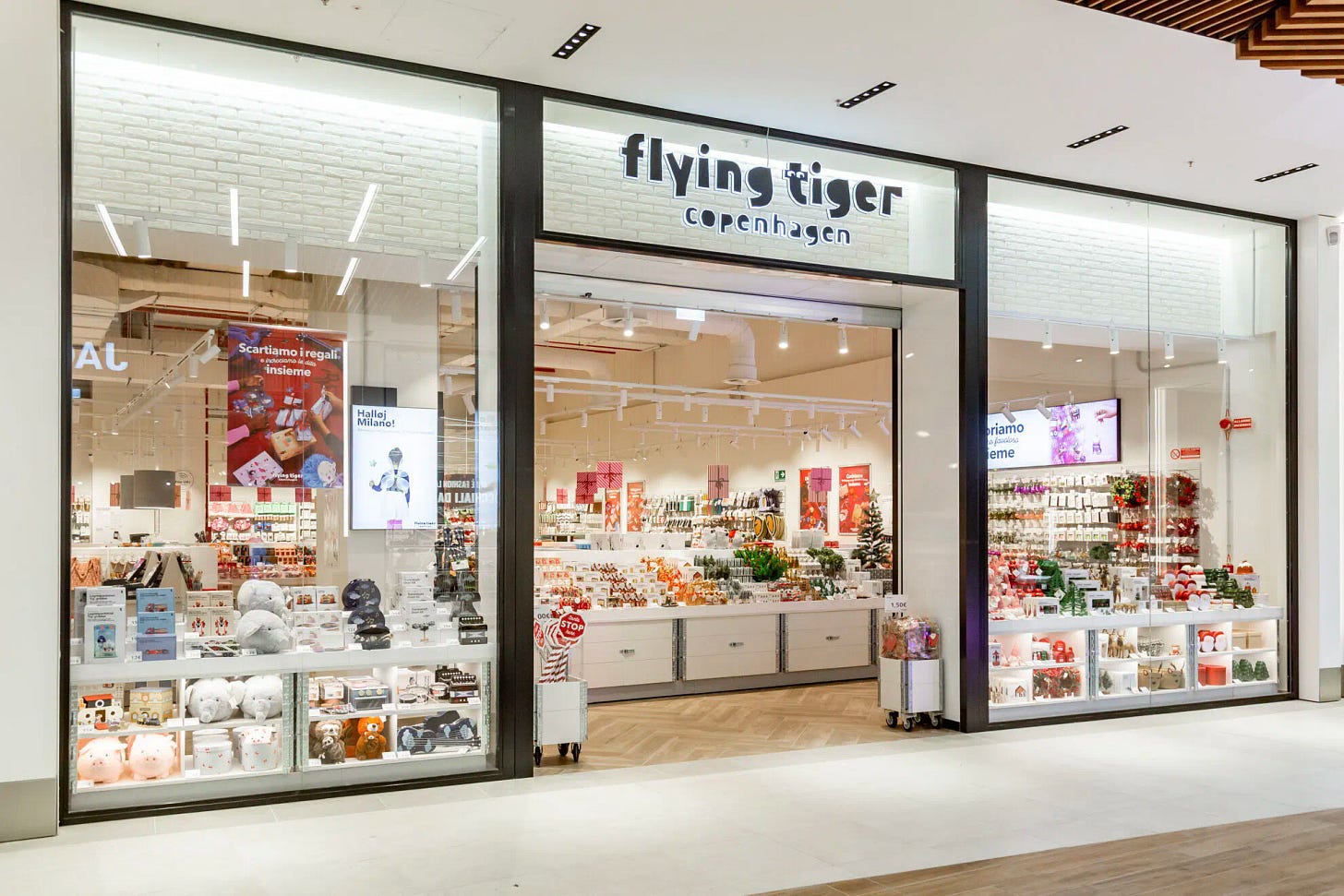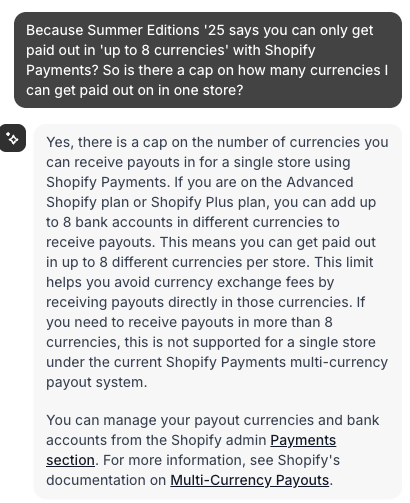The Great Shopify Unification
Multi-store Shopify brands are migrating back to a single store — here's why.

Intro
The great Shopify unification has begun.
A number of large, internationalised brands running multiple stores across regions — the US, Canada, UK, Japan, Korea, Europe, etc — seem to have reached a consensus: right now is the moment to begin consolidating to single store.
In this post I’ll answer:
Why?
Why now?
Is now the right time?
What are the migration challenges?
Let’s go!

Why?
The benefits. Ohhhhh the benefits.
Including but not limited to…
In Customer Experience
Consolidating to 1 store is a massive step towards ‘unified commerce’ for brands.
All customer data in one Shopify system unlocks big CX benefits.
Customers buying online in the UK, or buying in-store anywhere in the world — with a single Shopify store — have a ‘joined-up’ experience.
If the customer wants to return something in-store in LA they bought in the UK — easier.
If store staff want to pull up customer’s order history — easier.
If the customer wants to use a discount code in any store in the world — easier.
Managing loyalty schemes: 1 Shopify store, 1 customer account = easier.
In Operations
1 product catalog for Shopify. No more ‘sync to 1 store then duplicate to remaining stores and enrich in 8 places’. Big time-saver for eComm teams.
Unified reporting/analytics for Shopify data. No more manual merging datasets together to get a source of truth.
Much cleaner setup for inventory. Brands serving multiple Shopify stores from 1 warehouse, at the moment, either have to split stock between the stores (creating underselling), or show all stock on all stores and mitigate overselling using an app in the middle to reduce inventory on each store when orders are placed (which usually needs gets turned off during BFCM because it can’t process fast enough). That won’t be needed anymore.
1 set of ecomm and app costs. 1 Shopify store. 1 Matrixify. 1 Re-Charge. No need for Syncio. Consolidated Klaviyo costs. Lower Yotpo costs. Lower Algolia costs. Gorgias, LoyaltyLion, etc etc etc. Could add up to strong savings for brands. And, even if the cost of certain apps is the same with single store, the ease of management is greater, so still a win.
Lower integration/iPaaS costs. If their integrator(s) charge by ‘stream’ and/or data volume processed, given that brands will be significantly reducing the number of streams and data processing needed, they will also be significantly reducing their costs with their integrator(s). Say a brand has 10 stores. Now, instead of 10 sales order streams to ERP and/or WMS, it’s possibly as low as 1. Product streams down 10 to 1. Inventory streams down from 10 to 1. Fulfilment streams down from 10 to 1. The result = savings.
Why Now?
A perfect storm of:
The maturation of the Shopify platform
Developments in Markets (now “International”) and Markets Pro (now “Managed Markets”) are making single stores for localisation redundant.
Checkout customisation has improved.
Regional shipping and payment methods are now supported.
Payouts in multiple currencies from 1 store now supported.

The trend towards ‘unified commerce’
Brands better understand the benefits to the customer experience of getting all customer data unified into a single platform .
Brands like Passenger, Adanola and Rains providing social proof
5 years ago the DTC model of the market leaders, like Gymshark, was multi-store. Any brand expanding with purpose into new markets spun up a new Shopify store.
Single store was for brands doing lots of domestic business and very little international. There were very few examples of an internationally successful brand using single store.
Now, there are.
The macro-economic conditions putting cost-cutting back on the agenda
The covid-boom in the rearview mirror, de minimis loophole closed, tariffs, cost of living issues affecting consumer behaviour, et al.
Is Now The Right Time?
All considered, my view is yes.
The direction of travel is inevitable.
Eventually, brands are going to do this.
Brands that get there first get the benefits earlier.
Not to make the migration sound easy because it won’t be, but big picture — the tech looks to be there or thereabouts, so there are few obvious technical reasons not to do this.
The only question is whether brands see enough benefit in the making the change now to justify enduring the cost and disruption that comes with the change process.
Some brands will argue that waiting and migrating later will mean the migration process is easier, cheaper and less risky.
In some ways that will be proven right. The front-end migration process has been ‘playbooked’. The back-end process will be soon. And, Shopify’s releases consistently make the product stronger. In 2 more editions, maybe cross-border is a lot easier? Maybe order routing is a lot more advanced?
But, those brands shouldn’t forget to calculate the opportunity cost of not getting to single store sooner.
They also shouldn’t forget that the longer they use multi-store, the more embedded they likely become with those stores, and the harder it may be to eventually move.
Whenever this migration happens, it’s going to be difficult. My read is that the gains of waiting and moving later will likely be outweighed by the opportunity cost of not making the switch sooner.
What Are The Migration Challenges?
Perhaps quicker to list what aren’t the migration challenges. There’s loads of stuff going on here. Considerations for a number of teams inside the brand.
For finance there’s payouts and currency conversion fees. Shopify supports payouts in 8 currencies in a single store, their chatbot reluctantly confirmed…
… meaning a brand using a single store to sell in Australian Dollars, Canadian Dollars, US Dollars, HK Dollars, Norwegian Krone, Swedish Krona, SA Rand, Japanese Yen, Pounds, Francs, Forints and Zloty, for example, would only be able to get paid out in 8 of these currencies, bringing conversion charges on the rest where previously there might not have been any.
For Ops & Tech there’s a big list of questions to answer.
How will a single Shopify store handle per-market nuances in taxes and duties across all of the markets brands operate in?
Are Shopify’s order routing features compatible with how the brand wants to fulfil?
How does the move impact system integrations?
How best to migrate the customer data into the single store?
What are the digital and real-world steps to integrate PoS into the single store setup?
What other suppliers are affected by the migration?
Customer service will all be working in one site — if some of those teams are outsourced, how to make that happen harmoniously?
And the questions keep flowing for the eComm team…
Are they fully aware of the localisation limitations of single store?
What changes are needed to maintain site performance post-merge?
Will the checkout run slow under sheer weight of market-specific payment and shipping options?
How to mitigate the SEO impact of the change?
Are all apps used today compatible with a single store WoW?
How to nail market-specific discounts and promotions?
For Merch, there’s a change of process in how products and pricing are pushed to online. Market-specific products have to be handled differently now.
For Retail, there is a cutover process to be done with in-store staff.
For Brand, there’s a new challenge to strike the right balance between cohesive branding across the one store, and localised elements.
You get the picture! Lots to think about. But, nothing too big and scary if approached with clear thinking and patience.
Summary
Thanks for sticking with me folks: I know I have a tendency for the verbose (like in this very sentence, come to think of it…).
If you take anything away from this, let it be these points:
Multi-store, internationalised brands are starting to move on single store now.
Which makes sense, because the benefits are potentially huge.
The unification projects will be very tough, and some hidden limitations of Shopify are certain to be revealed in the process, making compromise a necessity for success.
It might not pay to wait on this. Unification will likely always be difficult, and while-ever you’re multi-store while single store is an option, you’re leaving money and time on the table.
Until next time.






